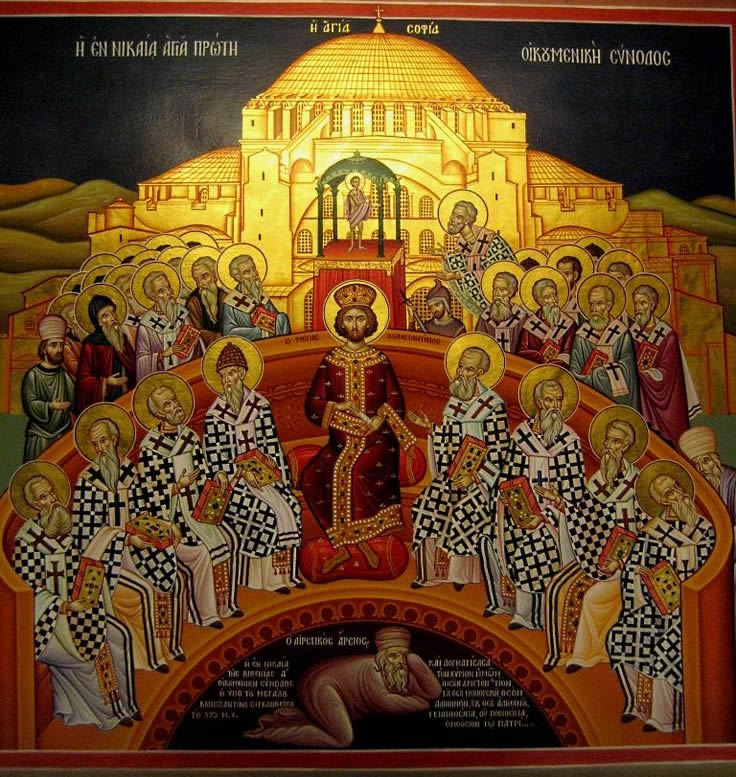 |
| Caesaropapism |
Caesaropapism is the idea that the emperor had complete control over the Orthodox Greek Church in the Roman/Byzantine Empire, relegating the church to something like a department of state, subordinate to, rather than independent from, imperial power.
This is a western perspective never found in Byzantine sources. In the Byzantine/Orthodox perspective there was, ideally, a harmony between emperor/imperial power (imperium) and church/ecclesiastical power (sacerdotium), not a domination and subordination, respectively.
The relationship of church and Roman state changed drastically after the conversion of Emperor Constantine the Great (d. 337). Up to this time Christianity had been a persecuted minority sect far from the wealth and power of the imperial palace and Roman aristocracy.
By that time the church had developed a strong and effective organizational structure and leadership as well as a means of regulating problems (though these did not always prove successful) through local councils. After Constantine’s conversion the church was raised to a new level of affluence and power, as bishops now became figures of wealth and influence. Imperial patronage of the church also meant imperial involvement in the church and, conversely, church involvement in politics.
The emperor was constantly concerned to ensure peace in the church and took action when theological controversies threatened to rend it into competing factions because these quickly devolved into quasi-political factions. The emperor did not decide such controversies unilaterally. Instead, he relied on the church. The emperor, starting with Constantine I, summoned all bishops together to an ecumenical (“universal”) council where they could officially establish Orthodox doctrine and practice.
The Orthodox Church recognizes seven such councils (Council of Nicaea, 325; Council of Constantinople, 381; Councils of Ephesus and Chalcedon, 431, 451; Constantinople, 551; Constantinople, 680; Nicaea, 787). Nevertheless, these councils did not always lead to harmony, since those condemned often broke away (like Monophysites in Syria and Egypt after the Fourth Ecumenical Council).
 |
| Emperor in christian council |
In the later fourth century Emperor Theodosius I (d. 395) proclaimed the Orthodox Christian faith the only legal religion of the empire. Afterwards, adherence to the Orthodox theology of the emperor was the measuring stick for loyalty and citizenship in the empire. Church and state in Byzantium were thoroughly intertwined.
The emperor’s power was perceived as granted by God and visibly shown by his coronation at the hands of the patriarch in the great cathedral of Hagia Sophia. The emperor demonstrated his God-given duty by promoting Christianity, protecting the church, and enforcing its regulations. The emperor’s role in the church continued beyond calling ecumenical councils.
He also selected the patriarch of Constantinople, the leading cleric in the Orthodox Church. Usually the emperor selected him from a short list provided by a synod of clergy, but he could also choose another candidate altogether. Sometimes in fact, he chose a layperson, as he did with the ninth-century Patriarch Photius.
The emperor acted as an overseer of the church and was granted special privileges. He could enter the sanctuary (the area that is today behind the iconostasis), which was reserved only for clerics. He could also receive communion in the same fashion as priests. In addition, the emperor could preach sermons, as did Emperor Leo VI (d. 912), and bless the congregation.
He also enacted legislation regulating church activities and even, at times, on theology. The emperor could not, however, celebrate the Divine Liturgy; that was reserved only for ordained clergy. Here was one area distinguishing imperial (imperium) and the clerical power (sacerdotium). Yet, as is clear, in Byzantium, church and state were linked together in an inseparable fashion.
There was no clear-cut distinction between the impact of canon (kanon) and civil (nomos) law on the Byzantine community. In the 12th century canonist Theodore Balsamon declared that the emperor regulated both civil and canon law and argued that the emperor himself was not limited by canon law. Yet, this was only in theory.
In reality, the emperor was indeed limited in his control over orthodoxy. While he could remove bishops and appoint their replacements, he answered to the church. When the popular patriarch John Chrysostom was removed in the early fifth century, the rioting in Constantinople burned whole regions of the city. Moreover, the emperor could not permanently alter doctrine without the support of the church and especially the great defenders of orthodoxy, monks.
In the seventh century emperors championed the doctrine of Monotheletism (which asserted that Christ had only one will for both his divine and human nature); despite their efforts it failed, because of the opposition clergy and monks, like Maximus. In the eighth and ninth centuries the controversy over iconoclasm was driven by the imperial palace and opposed fiercely by monks like John Damascene and Theodore the Stoudite.
This too failed. In the 10th century, Emperor Nikephoros Phokas wanted the church to recognize as martyrs all Christians who died fighting Muslims. The patriarch rejected this. In the 11th century, tension between the bishops of Rome (of the Latin Church) and Constantinople (of the Greek Church) led to the Schism of 1054 that separated the Catholic and the Orthodox Churches—despite imperial efforts to prevent it.
In the 13th–15th centuries Byzantine emperors, desperate for military support from the west, attempted to submit the Orthodox Church to the papacy (at the Council of Lyons in 1274 and the Council of Florence in 1438–1939) but were foiled by monks and clerics unwilling to yield theologically. While the emperor had a level of practical power, this power was checked by the tradition of the church and by the unyielding commitment to principle of monastic and clerical defenders.
Finally, despite the name (Caesaropapism) emperors never claimed to have the authority over the church as the pope, the bishop of Rome, did in the west. Despite the power of the emperor, he did not have complete control over the church, as the word implies. He was not pope and emperor of the Orthodox Church.
EmoticonEmoticon